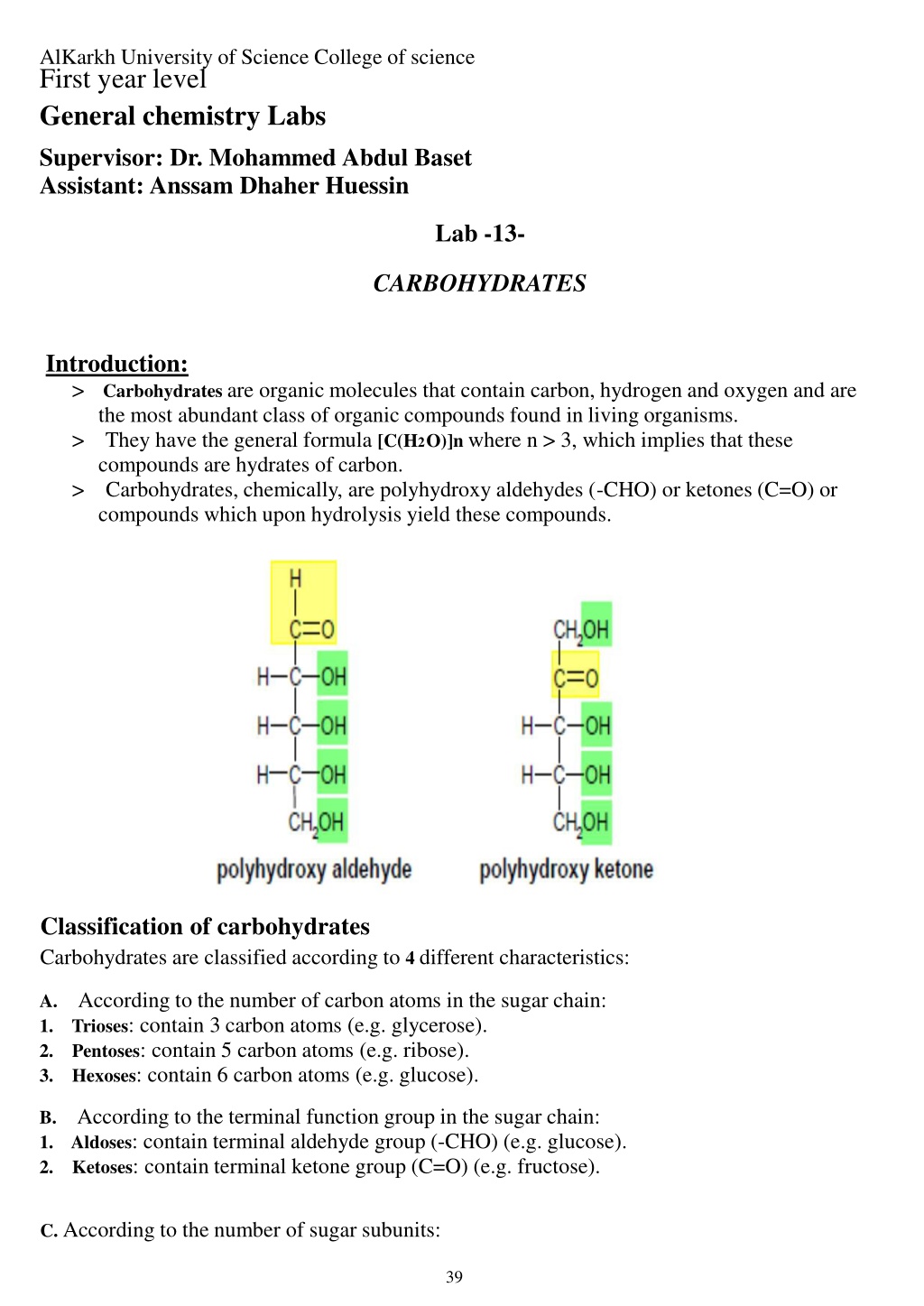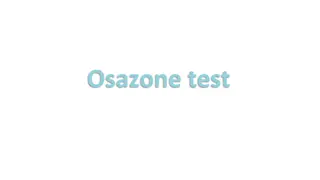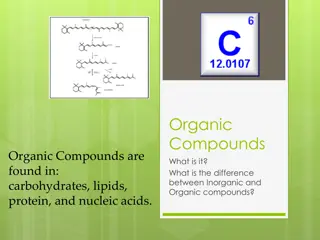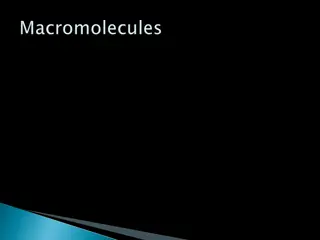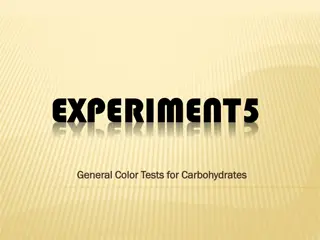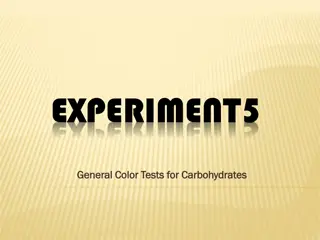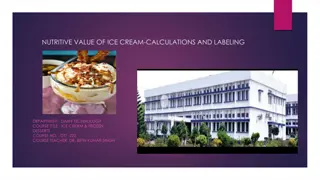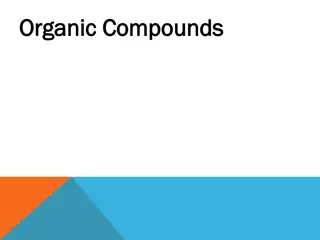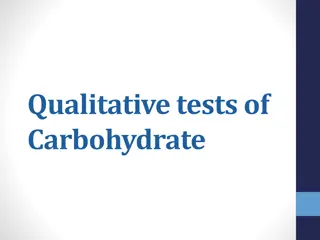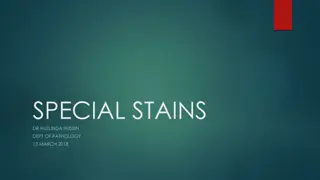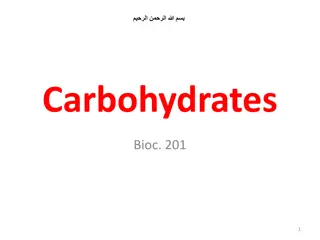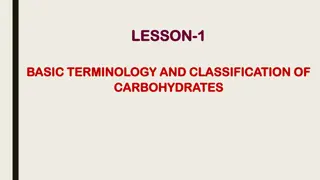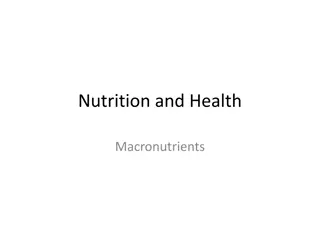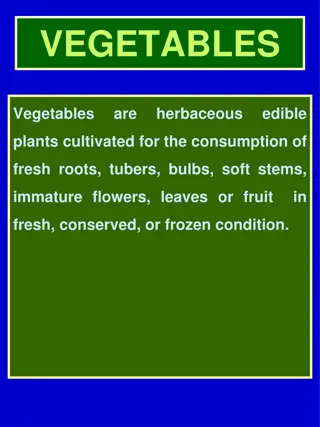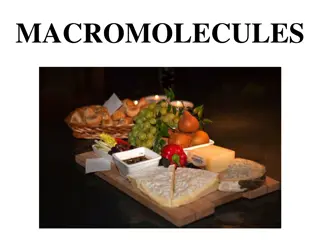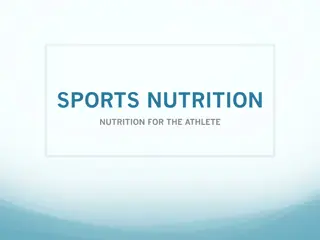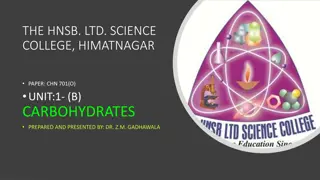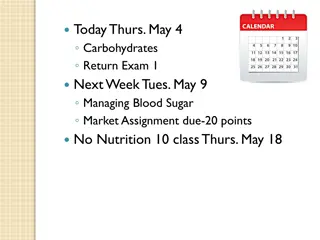Understanding Carbohydrates: A Comprehensive Overview
Carbohydrates are essential organic compounds found abundantly in living organisms, containing carbon, hydrogen, and oxygen. This summary delves into the classification of carbohydrates based on characteristics like the number of carbon atoms, terminal function groups, and the number of sugar subunits. It discusses monosaccharides, disaccharides, and polysaccharides, emphasizing their structures and functions in biological systems. Furthermore, it explores common examples such as starch, glycogen, and cellulose, highlighting their significance in energy storage and structural support. Overall, this overview provides a foundational understanding of carbohydrates and their diverse roles in nature.
Download Presentation

Please find below an Image/Link to download the presentation.
The content on the website is provided AS IS for your information and personal use only. It may not be sold, licensed, or shared on other websites without obtaining consent from the author. Download presentation by click this link. If you encounter any issues during the download, it is possible that the publisher has removed the file from their server.
E N D
Presentation Transcript
AlKarkh University of Science College of science First year level General chemistry Labs Supervisor: Dr. Mohammed Abdul Baset Assistant: Anssam Dhaher Huessin Lab -13- CARBOHYDRATES Introduction: > Carbohydrates are organic molecules that contain carbon, hydrogen and oxygen and are the most abundant class of organic compounds found in living organisms. > They have the general formula [C(H2O)]n where n > 3, which implies that these compounds are hydrates of carbon. > Carbohydrates, chemically, are polyhydroxy aldehydes (-CHO) or ketones (C=O) or compounds which upon hydrolysis yield these compounds. Classification of carbohydrates Carbohydrates are classified according to 4 different characteristics: A. According to the number of carbon atoms in the sugar chain: 1. Trioses: contain 3 carbon atoms (e.g. glycerose). 2. Pentoses: contain 5 carbon atoms (e.g. ribose). 3. Hexoses: contain 6 carbon atoms (e.g. glucose). B. According to the terminal function group in the sugar chain: 1. Aldoses: contain terminal aldehyde group (-CHO) (e.g. glucose). 2. Ketoses: contain terminal ketone group (C=O) (e.g. fructose). C. According to the number of sugar subunits: 39
1. Monosaccharides: they contain a single sugar unit (e.g. glucose & fructose). The a symbol indicates the stereoisomer in which the hydroxyl group lies below the plane of the ring. When this hydroxyl group is shown above the plane, the designation is p. The a cyclic structures of galactose, fructose, and ribose, are given below. 2. Disaccharides: > They are made up of two monosaccharide units linked together. > The most abundant disaccharide is sucrose, which is hydrolyzed to D-glucose and D- fructose. > The two sugar units are covalently joined through an oxygen atom at carbons 1 and 2 on glucose and fructose, respectively. > The covalent link between the two sugar units is referred to as an (a1^p2) glycosidic linkage. e.g. Sucrose (glucose + fructose) e.g. Lactose (glucose + galactose) e.g. Maltose (glucose + glucose) 40
3. Polysaccharides: They are made up of many monosaccharide units linked together. > Starch is a homopolysaccharide synthesized by plants for the storage of a-D-glucose units and serves as a source of carbohydrates in animal diets. a- amylose is a linear polymer of several thousand glucose units joined by a(1 4) glycosidic bonds. Amylopectin is a branched polymer with glucose connected in linear chains by a(1 4) bonds and by a(1 6) bonds at the branch points which occur on the average every 24 to 30 glucose units. Containing up to a million glucose residues, amylopectin is the larger of the two polymeric structures. > Glycogen, the storage polysaccharide for glucose in animals and humans is structurally similar to amylopectin except that branching occurs every 8 to 12 glucose residues. > Cellulose is an organic compound with the formula (C6H10O5)n, a polysaccharide consisting of a linear chain of several hundred to many thousands of P(1 >4) linked D- glucose units. Cellulose is an important structural component of the primary cell wall of green plants, many forms of algae. The cellulose content of cotton fiber is 90%, that of wood is 40-50% and that of dried hemp is approximately 45%.Cellulose is mainly used to produce paperboard and paper. Smaller quantities are converted into a wide variety of derivative products such as cellophane and rayon. Conversion of cellulose from energy 41
crops into biofuels such as cellulosic ethanol is under investigation as an alternative fuel source. Cellulose for industrial use is mainly obtained from wood pulp and cotton. D. According to the reducing activity of the sugar unit: Carbohydrates that can undergo oxidation are called reducing sugars. This depends on the presence of an exposed carbonyl group. 1 2 1. Reducing sugars: all monosaccharides & many disaccharides (e.g. lactose and maltose) are reducing sugars. 2. Non-reducing sugars: eg. sucrose. 42
Molischs test (For all carbohydrates): 1. Principle: Concentrated sulphuric acid causes dehydration of all carbohydrates to give furfural compounds (heterocyclic aldehyde), that react with a-naphthol (Molisch's reagent) giving a violet or purple colored complex. Carbohydrate solutions (1 g/l and 10 g/l), Sulphuric acid (concentrated), Molisch s reagent (a- naphthol 50 g/l in ethanol, prepare fresh), Beaker, test tubes, graduated pipettes, funnel, filter paper, watchglass. 3. Procedure: 1- In a test tube, add 2 ml of the test carbohydrate solution + 2 drops of a-naphthol solution. 2- Carefully pour dropwise 1ml conc. H2SO4, using a dropper, on the inner wall of test tube. 4. Observation: 1- A "violet colored ring" appears at the junction between the two layers. 2- If the purple layer is difficult to see, mix slowly and carefully (large amounts of heat is generated) and observe the colour. If the test solution sugar concentration high enough all the solution become purple color. 43
